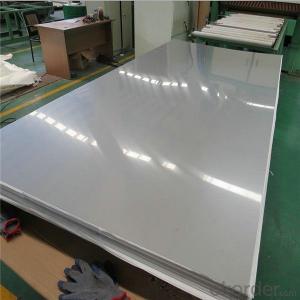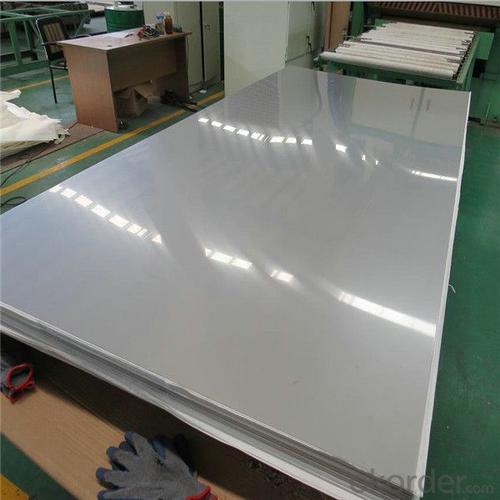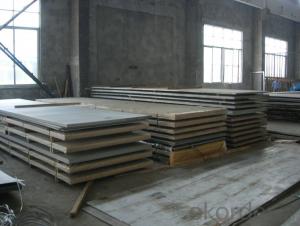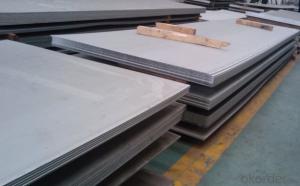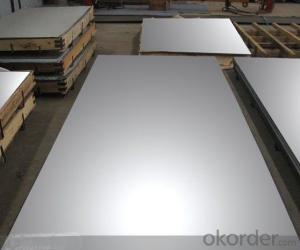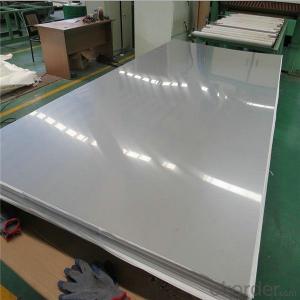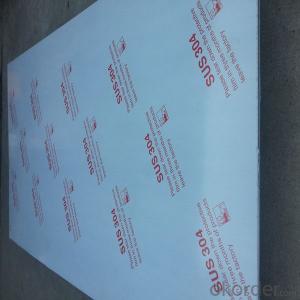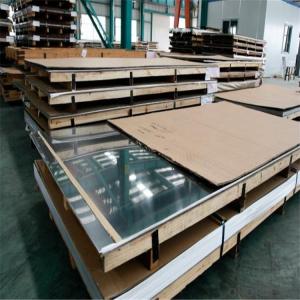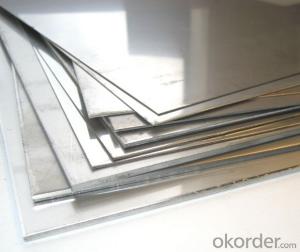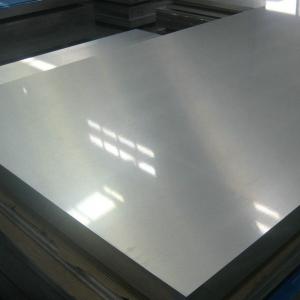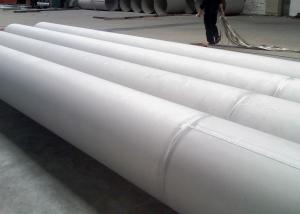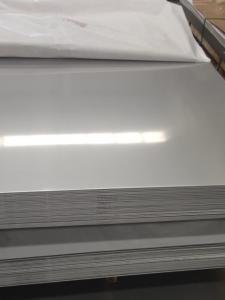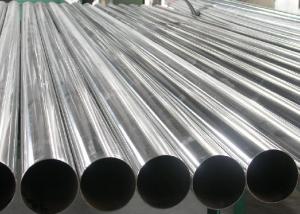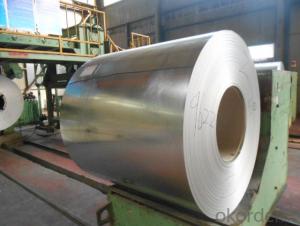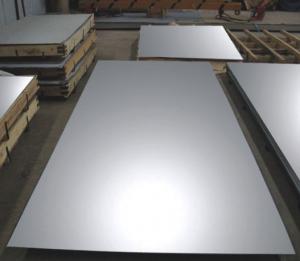100-3500mm width 201 BA stainless steel sheet
- Loading Port:
- Shanghai
- Payment Terms:
- TT OR LC
- Min Order Qty:
- 2 m.t.
- Supply Capability:
- 35000 m.t./month
OKorder Service Pledge
OKorder Financial Service
You Might Also Like
Specification
201 BA stainless steel sheet
1) Material:201,202,304,316L,310S,321.430,410, 304L,2205,317L
2) Size:thickness0.1-16mmxwidth1000-2000mm
3) Certificate:ISO
4) Standard:JIS, AISI, ASTM, GB, DIN, etc.
5) Craft:Hot rolled/cold rolled
6) Surface:No.1,2B,BA.HL.NO.4.
Surface finish | Characteristics and application |
NO.2B | The surface brightness and flatness of no2B is better than no2D. then through a special surface treatment to improve its mechanical properties,No2B could nearly satisfy comprehensive uses. |
NO.3 | Polished with abrasive belt of git#100-#200, have better brightness with discontinuous coarse stria, used as inner and external ornaments for building, electrical appliances and kitchen utensils etc. |
NO.4 | Polished with abrasive belt of grit #150-#180,have better brightness with discontinuous coarse stria,but thinner than No3, are used as bathtub buildings inner and external ornaments electrical appliances kitchen utensils and food processing equipment etc. |
HL | Polished with abrasive belt of grit #150-#320 on the NO.4 finish and has continuous streaks, mainly used as buildings ornaments elevators,door of building, frontal plate etc. |
BA | Cold rolled, bright annealed and skin-passed, the product have excellent brightness and good reflexivity like mirror,kitchen apparatus,ornament etc. |
8K | The product have excellent brightness and prefer reflexivity can to be the mirror. |
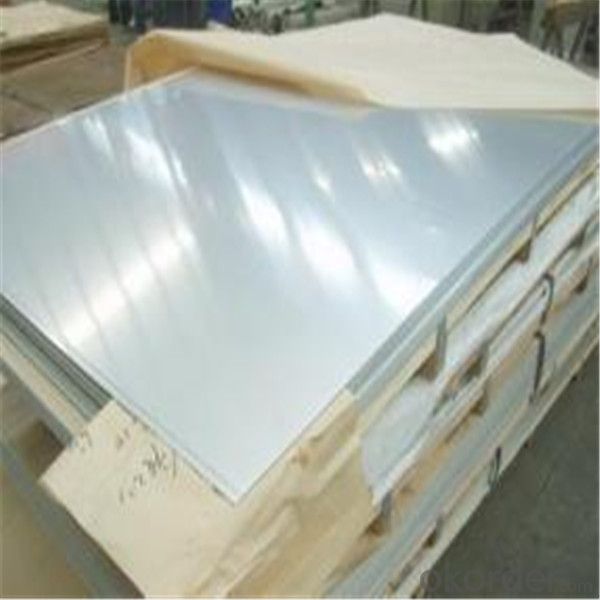

Our Advantages
• All products are made of high-quality imported raw materials.
• Our products are certified by ISO9001:2008 authentication quality systems.
• we are nominated as the AAA enterprise by Jiangsu government.
• Quick Response to Your Enquiry.

- Q: How do you prevent discoloration on stainless steel sheets?
- To prevent discoloration on stainless steel sheets, there are several measures you can take. 1. Regular Cleaning: Proper and regular cleaning is essential to prevent discoloration on stainless steel sheets. Use mild soap or detergent and warm water to clean the surface. Avoid using abrasive cleaners or scrubbing pads as they can cause scratches that may lead to discoloration. 2. Avoid Harsh Chemicals: Avoid using harsh chemicals or cleaners containing chlorine, bleach, ammonia, or acids as they can cause pitting or corrosion on the stainless steel surface, leading to discoloration. Stick to mild and non-abrasive cleaners specifically designed for stainless steel. 3. Rinse Thoroughly: After cleaning, make sure to rinse the stainless steel sheet thoroughly with clean water to remove any residue from the cleaning solution. Residual chemicals can cause discoloration if left on the surface for an extended period. 4. Dry Completely: After cleaning and rinsing, it is important to dry the stainless steel sheet completely. Moisture left on the surface can lead to water spots or staining, especially in environments with hard water. Use a soft cloth or towel to remove all moisture, ensuring a dry and shiny surface. 5. Protective Coatings: Applying protective coatings or sealants designed for stainless steel can help prevent discoloration. These coatings create a barrier that protects the surface from environmental factors, such as humidity, oxidation, and staining. 6. Proper Handling and Care: Avoid dragging or sliding objects across stainless steel sheets, as this can cause scratches or abrasions that may lead to discoloration. Handle the sheets with care, using clean gloves or a soft, non-abrasive cloth to minimize the risk of surface damage. 7. Regular Maintenance: Regularly inspect the stainless steel sheets for any signs of discoloration or damage. Promptly address any issues by following the appropriate cleaning and maintenance procedures to prevent further damage and maintain the appearance of the stainless steel. By following these preventive measures, you can effectively minimize discoloration on stainless steel sheets and keep them looking clean, shiny, and stain-free for a longer period.
- Q: Can stainless steel sheets be used for kitchen utensils?
- Yes, stainless steel sheets can be used for kitchen utensils. Stainless steel is a popular choice for kitchen utensils because it is durable, easy to clean, and resistant to rust and corrosion. Stainless steel sheets can be shaped and formed into various utensils such as spoons, forks, knives, spatulas, and more. Additionally, stainless steel is non-reactive, meaning it does not leach any harmful chemicals into food, making it a safe option for cooking and eating utensils. Overall, stainless steel sheets are a great material choice for kitchen utensils due to their strength, hygiene, and longevity.
- Q: Are stainless steel sheets resistant to abrasion?
- Yes, stainless steel sheets are generally resistant to abrasion. Stainless steel is known for its high strength and durability, making it less prone to scratches and wear compared to other materials. It has a smooth surface that can withstand friction and abrasion, making it suitable for various applications where resistance to scratches and wear is required. However, it is important to note that the level of resistance can vary depending on the specific grade and finish of stainless steel used.
- Q: What is the maximum thickness of a stainless steel sheet?
- The maximum thickness of a stainless steel sheet can vary depending on the specific grade or type of stainless steel being used. In general, stainless steel sheets can range from as thin as 0.4 millimeters (0.0157 inches) to as thick as 100 millimeters (3.937 inches) or more. However, it is important to note that the availability of thicker sheets may be limited and can vary based on the supplier or manufacturer. Additionally, some stainless steel alloys may have different thickness limits due to their composition and intended use. Therefore, it is always recommended to consult with a supplier or refer to the specifications provided by the manufacturer to determine the maximum thickness of the specific stainless steel sheet you require.
- Q: Are stainless steel sheets resistant to heat?
- Yes, stainless steel sheets are highly resistant to heat. Stainless steel is a type of steel alloy that contains a high percentage of chromium, which provides excellent heat resistance properties. This enables stainless steel sheets to withstand high temperatures without warping, deforming, or losing their structural integrity. Stainless steel sheets are commonly used in applications that require heat resistance, such as in the construction of ovens, cookware, industrial equipment, and automotive parts. Additionally, stainless steel sheets also have good oxidation resistance, which means they can maintain their appearance and properties even at elevated temperatures. Overall, stainless steel sheets are an excellent choice for applications where heat resistance is a crucial requirement.
- Q: Can stainless steel sheets be used for staircase railings?
- Certainly! Staircase railings can indeed utilize stainless steel sheets. Stainless steel stands out as a favored option for such railings owing to its exceptional durability, strength, and resistance against corrosion. By cutting, shaping, and welding stainless steel sheets, a multitude of railing designs and styles can be crafted. Additionally, these sheets can be finished in various manners, such as brushing or polishing, to achieve the desired aesthetic appeal. Not only do stainless steel railings offer an appealing appearance, but they also furnish a secure and robust support for staircases.
- Q: 304 stainless steel has several advantages, a few big advantages, the more concrete the better
- 304 stainless steel is a universal stainless steel material, antirust performance than the 200 series of stainless steel material stronger. High temperature resistance is also good, the general use of temperature limit is less than 650 degrees centigrade.
- Q: Are stainless steel sheets resistant to staining from food?
- Stainless steel sheets possess a remarkable resistance to staining caused by food. Renowned for its exceptional corrosion resistance and non-reactivity with various substances, including food, stainless steel stands as a favored choice for kitchen appliances and cookware. Its capacity to endure prolonged exposure to food without staining or undergoing chemical reactions makes it highly sought-after. Moreover, stainless steel sheets are effortless to clean, making them the perfect fit for food preparation areas where cleanliness is of utmost importance. Furthermore, the sleek and impermeable surface of stainless steel sheets prevents the absorption of food particles and liquids, thus minimizing the risk of staining. In summary, stainless steel sheets offer a long-lasting and stain-resistant alternative for applications related to food.
- Q: What is the impact strength of stainless steel sheets?
- The impact strength of stainless steel sheets can vary depending on several factors, such as the grade and thickness of the stainless steel, as well as the specific conditions under which the impact occurs. Generally, stainless steel has a good level of impact strength due to its inherent properties, including its high tensile strength and ductility. Stainless steel is known for its ability to withstand impacts and resist deformation, making it a preferred material in various industries where durability is crucial. It exhibits excellent resistance to impact loading, which means it can withstand sudden impact forces without fracturing or breaking. This makes stainless steel sheets suitable for applications that require high impact resistance, such as structural components, automotive parts, and machinery. However, it is important to note that different grades of stainless steel have varying impact strengths. Some grades, such as austenitic stainless steels (e.g., 304 and 316), have excellent impact resistance due to their high nickel and chromium content. On the other hand, ferritic and martensitic stainless steels may have slightly lower impact strengths. In addition to grade, the thickness of the stainless steel sheet also plays a role in determining its impact strength. Thicker sheets generally have higher impact resistance compared to thinner ones, as they can absorb more energy before yielding or fracturing. It is worth mentioning that the impact strength of stainless steel can be further enhanced through various methods, including heat treatment and alloying. These processes can improve the material's toughness and resistance to impact loading. Overall, stainless steel sheets have a good impact strength that is suitable for many applications. However, it is recommended to consult the specific grade and thickness specifications, as well as any industry standards or regulations, to determine the exact impact strength requirements for a particular application.
- Q: How do I prevent stress corrosion cracking on stainless steel sheets?
- To prevent stress corrosion cracking on stainless steel sheets, there are various steps that can be taken: 1. Opt for the appropriate stainless steel grade: Select a stainless steel grade that is resistant to stress corrosion cracking (SCC). Although grades like 304 and 316 generally have good SCC resistance, certain applications may necessitate higher alloyed grades like duplex or super duplex stainless steels. 2. Minimize exposure to corrosive environments: Limit the exposure of stainless steel sheets to environments known to cause stress corrosion cracking, such as chloride-rich or acidic surroundings. If avoiding exposure is not possible, consider applying protective coatings or barriers to shield the stainless steel from these corrosive elements. 3. Manage applied stress levels: Prevent subjecting the stainless steel sheets to excessive mechanical or thermal stresses. High tensile stresses can facilitate the initiation and propagation of stress corrosion cracking. Utilize appropriate design and fabrication techniques to ensure even stress distribution and minimize stress concentrations. 4. Maintain the surface condition: Ensure that the stainless steel sheets are devoid of surface contamination or defects that can serve as initiation sites for stress corrosion cracking. Regularly clean and inspect the sheets to eliminate any contaminants or corrosion products. 5. Employ inhibitors or cathodic protection: In certain cases where exposure to corrosive environments is unavoidable, the use of corrosion inhibitors or the implementation of cathodic protection techniques can help mitigate stress corrosion cracking. These methods work by reducing the corrosive activity on the stainless steel surface. 6. Handle and store properly: Exercise caution during transportation and storage to prevent excessive bending, vibration, or exposure to corrosive substances. Store stainless steel sheets in a clean and dry environment to avoid potential surface contamination. In conclusion, a combination of material selection, environmental control, stress management, surface maintenance, and proper handling can effectively prevent stress corrosion cracking on stainless steel sheets. It is advisable to consult with material experts or engineers to analyze specific application requirements and recommend the most appropriate preventive measures.
Send your message to us
100-3500mm width 201 BA stainless steel sheet
- Loading Port:
- Shanghai
- Payment Terms:
- TT OR LC
- Min Order Qty:
- 2 m.t.
- Supply Capability:
- 35000 m.t./month
OKorder Service Pledge
OKorder Financial Service
Similar products
Hot products
Hot Searches
Related keywords
